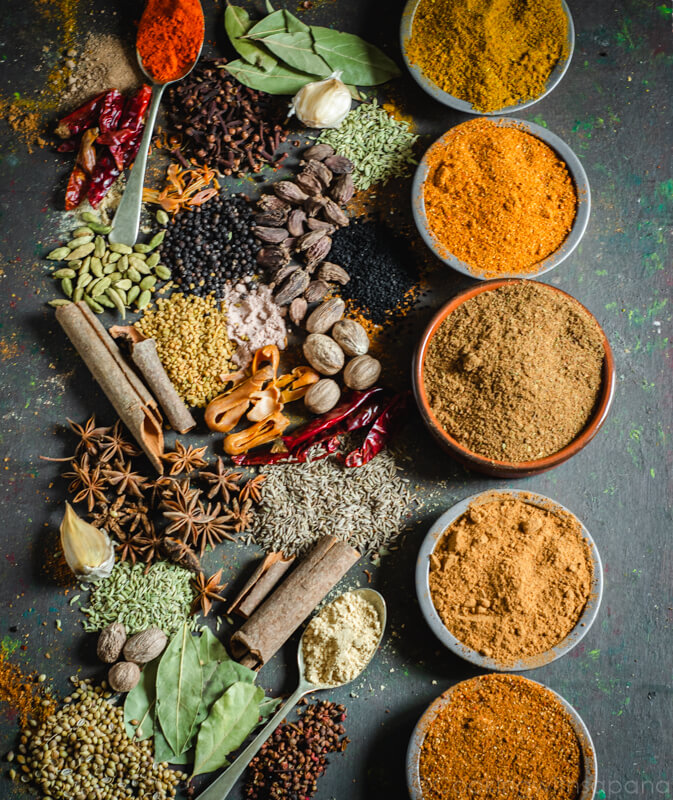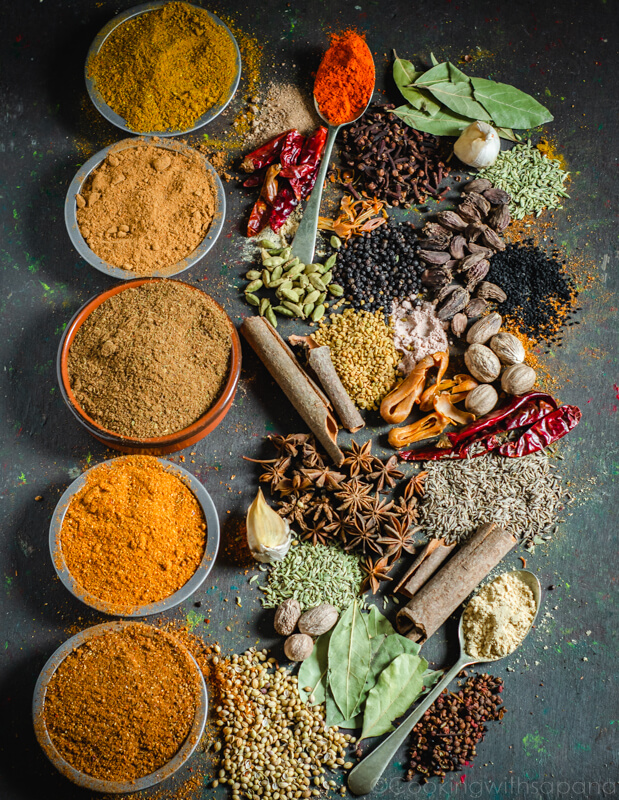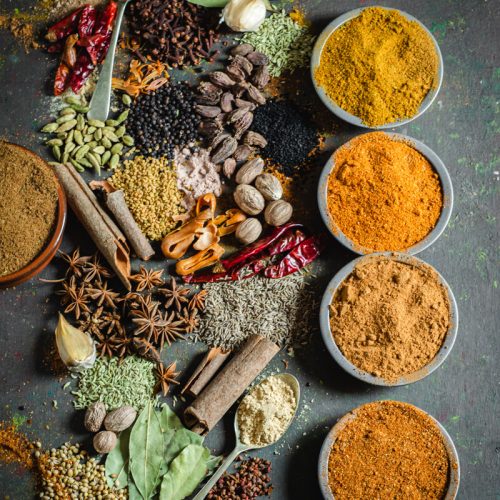5 commonly used Indian masala powder recipes, the quintessential spices used in Indian kitchen to cook all those wonderful dishes.

Spices or Masala Powders
Are you wondering how to make Indian spices at home? This post gives a detailed overview of 5 commonly used Indian masala powder recipes. Spices are an important part of Indian Cusine. If we ask someone to describe Indian Cusine in one word, the obvious answer will be Masaladar or spicy and without masala, there will be no fun left in Indian food.
Traditional Indian cooking is experimenting with different spice blends. The main benefit of making your own masala powder at home is you can prevent the spices from food adulteration. I make garam masala powder once in a year and use it whenever required. Try our recipe of Homemade chaat masala, Homemade garam masala, Homemade biryani masala, Homemade chana masala, and Homemade Pav Bhaji masala powder. Do let us know how it turned out?
Chaat masala powder
Chaat masala is the basic spice mix used in Indian cooking. Sprinkle it over salads and chaats, add in your raita or in lemonade. You name it and it will be a perfect companion with any dish of your choice. A further meaning of the word ‘chaat’ is licking, and literally you will be licking your fingers after trying this masala powder.
Homemade garam masala powder
The word ‘garam’ means hot and masala means a mixture of spices, so garam masala powder is basically a blend of whole spices that are considered to be used for the heating of the body in Ayurveda. It is used in most of the North Indian and Punjabi cuisine for that deliciousness and warmth.
Homemade biryani masala powder
Biryanis are one of the popular rice dishes in Indian cuisine. Wonder how the restaurants make biryanis so delicious?. It’s because of the biryani masala they add. So next time when you are trying the biryani at home, add this homemade biryani masala powder to make it even better than the restaurants.
Homemade chana masala powder
Chana masala is a very famous North Indian dish made with chickpeas. It’s a quintessential curry served in restaurants, hotels, marriages, and any other celebration throughout the country and worldwide. Now you will be able to make this delicious curry at home with our homemade chan masala powder.
Homemade Pav Bhaji masala powder
Pav Bhaji is one of the popular street food of Mumbai, Gujarat, and many other parts of India. Just like Vada Pav, Tawa Pulao, and Ragda Pattice, the local people love this pav bhaji as one of their staple lunch dishes. It is prepared with a blend of vegetables cooked in tomato and onion gravy and seasoned with pav bhaji masala powder. And what if you have your own homemade masala powder, I bet the pav bhaji is going to taste even more delicious.
Ingredients Needed for spices mix
- Cloves: Cloves or lavang are used as mouth fresheners, in spices and Paan (a sweet preparation of betel leaf with other aromatic spices) and readily used in culinary.
- Green cardamom: Green cardamom or Hari Elaichi in Hindi is an ancient spice popularly used in desserts.
- Black Cardamom: Black cardamom is known as Moti Elaichi in Hindi. It is an antiseptic and diuretic spice.
- Cinnamon sticks: Cinnamon sticks or Dalchini in Hindi, a spice that tastes awesome and is a major ingredient of Garam masala.
- Bay leaves: Bay leaves known as Tejpata in Hindi is a popular spice with a rich source of folic acid, Vitamin A and C.
- Black pepper: Black peppercorn or Kali Mirch in Hindi. Black pepper is one of the most interesting gifts to mankind from nature. It has anti-inflammatory properties, controls blood sugar, lower blood cholesterol, and gives unique peppery flavor to food.
- Star Anise: Star Anise is known as Chakri Phool in Hindi, a very common spice with numerous health benefits.
- Mace: Mace or Jaavirti in Hindi is tan- yellow to red color spice from dried aril, made up of smooth, hard, shiny branched fragrant pieces. It has both cinnamon and peppery flavors.
- Nutmeg: Nutmeg known as Jaiphal in Hindi, is used in soups, sauces, and baking.
- Dry Ginger: Dried ginger, a well-known spice or culinary help in many digestive ailments. It is an ancient Ayurvedic medicine for cold.
- Fenugreek seeds: Fenugreek seeds or methi dana are aromatic seeds of fenugreek leaves flower used for culinary and medicinal purposes.
- Cumin seeds: Cumin seeds or jeera is a very well-known spice used in every Indian kitchen to temper curries.
- Fennel seeds: Also known as saunf in Hindi, helps indigestion. Fennel tastes amazing in desserts and pickles.
- Caraway seeds: These seeds have a nutty flavor similar to aniseed, dill, and mint.
- Pomegranate seeds: Dried pomegranate seeds are extensively used in Punjabi recipes. They add tanginess to the dish.
- Dry whole red chili: Dried red chili or Sukhi Lal Mirch in Hindi, add color and spice to any spice mix or dish.
- Mango powder/amchoor: Dried mango powder or amchoor is a tangy powder made with dried mangoes. It adds a nice tangy flavor to any dish.
- Black salt: Also known as kala namak. It adds a pungent sulfur flavor in the chaat masala.
How to make 5 Indian masala powder?
Pick the ingredients separately to make each of the masala powder. Dry roast if required. Grind to make a fine powder using a mixer grinder. Store in air tight containers. Refrigerate for longer uses.
Pro Tips
- Always pick and clean the spices to ensure there isn’t any adulteration.
- If the spices packaging is opened for a long time or they look moist, make sure to dry roast and cool them before grinding.
- Store the spices mix in airtight containers only. The extra amount can be stored in the refrigerator for a longer shelf life.
- In order to avoid confusion label the containers properly.

Looking for more recipes to get some ideas for your lunch or dinner? Do not miss my Instant Wheat Dosa and Idli Recipe and the best one’s Millet Vada.
*If you ever try this recipe don’t forget to share your photos with me on Facebook, Pinterest, Twitter or tag me on Instagram @cookingwithsapana using the hashtag #cookingwithsapana and stay connected* I would love to see your creations from my space!!

5 commonly used Indian masala powder recipes
Equipment
- Skillet/Tawa
- Grinder
Ingredients
For chaat masala powder
- 1/4 cup roasted cumin seeds
- 1/4 cup amchoor/dry mango powder
- 2 tablespoon red chili powder
- 1 tablespoon black salt
- 1 tablespoon salt
For garam masala powder
- 1/2 cup cumin seeds
- 1/4 cup cloves
- 1/4 cup black pepper
- 8-10 star anise
- 1/4 cup green cardamom
- 8-10 black cardamom
- 10-12 bay leaves
- 8-10 cinnamon sticks
- 4-5 mace
- 2 tablespoon ginger powder/2-3 small pieces of dry ginger
- 1 tablespoon nutmeg powder/3-4 nutmeg
For biryani masala powder
- 8-10 dry whole red chili
- 1 tablespoon fenugreek seeds
- 2 tablespoon cumin seeds
- 1 tablespoon cloves
- 2 tablespoon black pepper
- 7-8 bay leaves
- 3-4 mace
- 3-4 cinnamon stick
- 7-8 black cardamom
- 8-10 green cardamom
- 1 tablespoon fennel seeds
- 1 tablespoon ginger powder/2″ dry ginger
- 1 tablespoon turmeric powder
For chana masala powder
- 8-10 dry whole red chili
- 2 tablespoon cumin seeds
- 1 tablespoon caraway seeds
- 2 tablespoon coriander seeds
- 2 tablespoon pomegranate seeds
- 1 tablespoon cloves
- 7-8 black cardamom
- 1 tablespoon dried fenugreek leaves/kasoori methi
- 3-4 cinnamon sticks
- 3-4 mace
- 7-8 green cardamom
- 1 tablespoon amchoor/dry mango powder
- 1 tablespoon ginger powder/2″ ginger piece
- 1 tablespoon nutmeg powder/3-4 nutmeg
For pav bhaji masala powder
- 7-8 dry whole red chilli
- 2 tablespoon coriander seeds
- 2 tablespoon cumin seeds
- 1 tablespoon black pepper
- 1 tablespoon fenugreek seeds
- 1 tablespoon fennel seeds
- 7-8 green cardamom
- 1 tablespoon dried mango powder
- 8-10 cloves
Instructions
For chaat masala powder
- Dry roast the cumin seeds on a skillet until slightly dark in color. Let it cool.
- Grind with the rest of the ingredients and make a fine powder.
- Store in an airtight container.
For garam masala powder
- Dry roast the whole spices if desired.
- Grind to make a fine powder. Cool and store in an airtight container.
For biryani masala powder
- Dry roast the whole spices if desired.
- Grind to make a fine powder. Cool and store in an airtight container.
For chana masala powder
- Dry roast the whole spices if desired.
- Grind to make a fine powder. Cool and store in an airtight container.
For pav bhaji masala powder
- Dry roast the whole spices if desired.
- Grind to make a fine powder. Cool and store in airtight container.
Video
Notes
- Always pick and clean the spices to ensure there isn’t any adulteration.
- If the spices packaging is opened for a long time or they look moist, make sure to dry roast and cool them before grinding.
- Store the spices mix in airtight containers only. The extra amount can be stored in the refrigerator for a longer shelf life.
- In order to avoid confusion label the containers properly.
Always let me know how this recipe turned out in the comments below. I will be so excited to hear how you made your 5 commonly used Indian masala powders and please do share your tips and tricks with me.
Don’t forget that you can also find me on Facebook, Twitter, Instagram, YouTube, and Pinterest.
Best Regards,
Sapana Behl
This is such a great, informative post! I’ll be pinning this for future reference.
Thank you so much for posting this masala powder recipe! I usually just buy it but always wanted to make the spice from scratch. Inspiring!
It always amazes me all the great spices in Indian cooking. This is such a great post to learn what the spices are and how to use them.
This is a wonderful resource. I love having 5 different powders to use in one post. That’s so helpful! Thank you!
Never seen dried pomegranate seeds in the stores here, but this is such a helpful post – I love Indian spices!
I didn’t realize Masala was made out of a lot of the spices I’m familiar with. Thanks for sharing such great information.
This is so great and I love learning new spices recipe like this, thank you so much for sharing this with us I really appreciate it.
I’m Black and Puerto Rican, but I love making my own garam masala spice blend. It’s so easy and taste so much better than the mass produced stuff from the store.
Sometimes I get intimidated by making my own spice mixes but this post is so empowering, thanks for the tips!
Just what I was looking for! This looks like such a fun and easy recipe to try so thank you so much for sharing!
This was such a helpful post. I’m trying to learn to cook more Indian dishes and you provided a wealth of information!
Thanks for all the tips on how to pick and store spices. Looking forward to trying your chaat masala powder and garam masala powder recipes.
What a great way to learn more about popular Indian spices. I’m so glad I found this to add some of these to my collection for cooking.
I loved learning about all of the Indian spices. I cook with nutmeg, Star-Anise, and cardamom a lot. I love that you make the spices from scratch too.
I usually just buy ready made masala powders or curry pastes. But have always wanted to make my own. After reading this post, I’m going to try making some of my own. Bookmarking for later!
What a great post. Love the way you have explained all the spices. All are my favourite and pinned to share it with others.
Oh, I can imagine so many delicious uses for these masala spices! I bet it would liven up any dish!
I enjoy making my own spice blends and it is such a gift that you have shared these recipes with that gorgeous photo. I need to get some amchoor powder – it’s one ingredient I have not tried, and I see that Amazon has it if I can’t find it locally.
Thank you for sharing these masala mix recipes. My family and I love cooking with masala!
its very valuable information. Thank you for with us.
Thanks for sharing! I will surely try this
This is valuable information. Thanks for sharing.
Please check my blog and support me.
This is informative. Thanks for sharing